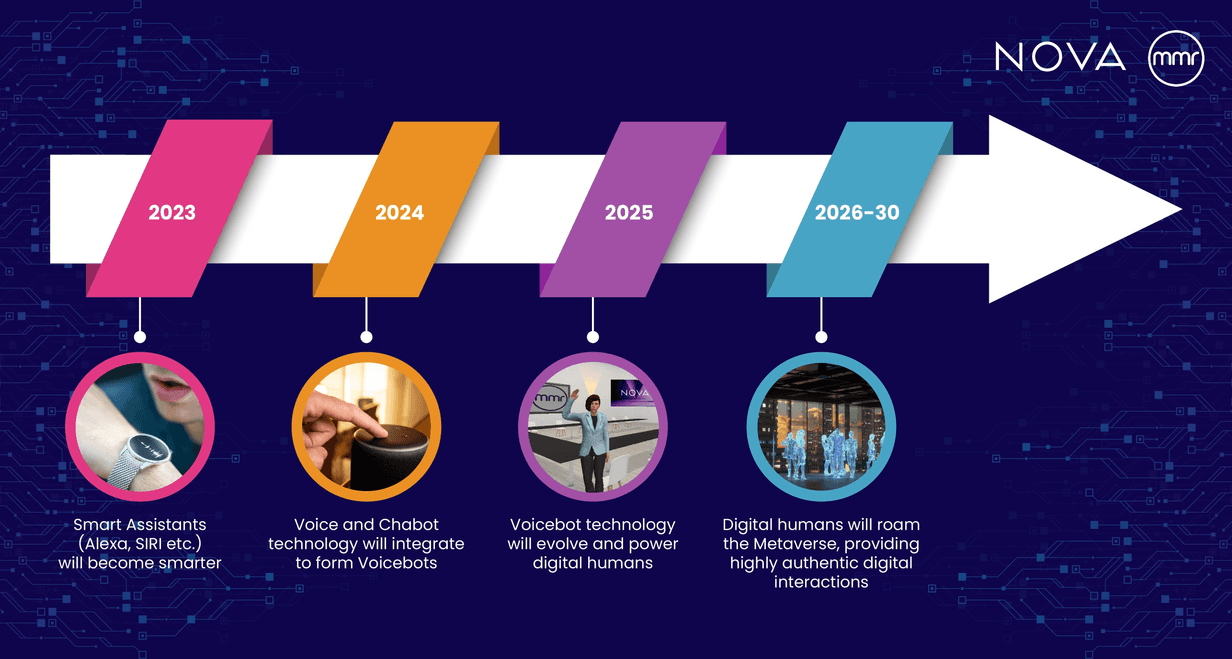Insights

28 Nov, 2025
Five Products: Showing How Sound Shapes Modern Consumer Experience
Read More
Alexandra Kuzmina | Innovation Consultant, NOVA tech innovation team @ MMR
17 Aug, 2022 | 3 minutes
Since the formation of NOVA just three years ago, the integration of tech into the research industry has been phenomenal. One of our most recent workstreams has been the exploration of smart assistants, looking to establish if they can add genuine value to the pursuit of consumer insight.
We are driven by a strong client need to immerse in the daily lives of consumers, capturing their in-the-moment thoughts, feelings, or behaviors, at scale. As a team, we have run dozens of experiments with several major CPG brands, and have charted what we believe is the likely path of evolution for these technologies.
In our estimation, smart assistants (both Chatbots and Voice AI) exhibit high potential for the insights industry. Conversational AI (better known as Chatbots) is already effective in helping brands understand the reasoning behind consumers’ responses.
In 2022, most of these platforms use messenger style interfaces to mine for more in-depth consumer verbatims. But with accelerated developments in Natural Language Processing (NLP) by companies such as IBM, Google, and Amazon, we expect Conversational AI to evolve rapidly and very soon expect to see AI technology capable of holding realistic consumer conversations that will provide the research industry with qualitative insight on a true quantitative scale.

Voice AI, whether powered by Amazon Alexa or Google Assistant, can already capture in-the-moment feedback when consumers’ hands are busy. But so far our own experiments have uncovered limitations with software functionality which stifle the user experience - however, as is the norm with modern tech, we expect these limitations to be eradicated by rapid software improvements. This is exciting news for CPG categories, where product use typically requires preparation, cooking, and multi-user interaction with children and pets.
With such developments, text based Chatbots will shortly evolve into Voicebots, integrating Chatbot and voice technology. This will have a significant impact on the quality of the insight gained in the moment. A voice-enabled chatbot conversation will be a far superior, more natural way to capture consumer feedback. Meta’s recent integration of WhatsApp calling and messaging commands with Ray-Ban Stories smart glasses adds a new dimension to the possibilities for connecting with consumers in-the-moment, in their own environment.
Despite massive leaps in text-based and voice AI technology, the user experience can still feel a little ‘robotic’, with the human subjects still receiving a disembodied response from a black box! Whilst undoubtedly useful, it could all feel a little like a side-show compared with the ambitious Metaverse visions set out by many brands recently.
This is why we believe we are about to see the next milestone for conversational and voice AI. Advancements in real-time video synthesis technology will herald the rise of virtual humans – photorealistic digital avatars that look and sound like real human beings. They will be either hyper realistic virtual copies of real people (digital twins), or high-fidelity digital characters who do not exist in real world. Both will manifest as ‘embodied’ voice-enabled programable chatbots and will be more engaging than current tools. They will be capable of replicating natural human interaction to elicit product or service feedback at scale – and that is exciting!
Early applications of virtual humans include AI kiosks in banks and unmanned grocery stores or restaurants. Nestle Toll House, for example, already dipped their toes into the digital human realm with their cookie baking assistant named Ruth. But it will be in the so-called metaverse (or metaverses) where they will become ubiquitous and gain wider acceptance with people, especially as more of us create and adopt our own avatars to roam the digital universe.
Virtual humans have the potential to revolutionize the way consumers engage with market research. What is currently still a relatively impersonal experience, may quickly evolve to become a scalable human level conversation.
At the early stages of adoption within the insights industry, digital humans will likely be used for giving information only. A good example of an information-giving virtual human is a virtual news anchor who is programmed to read the news. In the CPG insight industry context, the virtual human may be scripted as videos for giving information about the research project and accompanying consumers throughout their participation.
We envisage that virtual humans will eventually become conversational agents. These digital humans will have voice chatbots behind them that simulate human-like conversations. The combination of artificial intelligence and real time digital animation promises not only a more humanized experience for participants, but also time and cost efficiencies in product development for CPG brands.
MMR recognizes the pace of change in technology. Through our in-house tech team NOVA, we actively experiment with emerging technologies, often in collaboration with commercial players in CPG. Only when the tech has shown high potential to improve insight delivery will we develop commercial applications. If you want to explore the possibilities of new tech solutions, we would love to hear from you. There are always opportunities to partner with us.
Insights

28 Nov, 2025
Five Products: Showing How Sound Shapes Modern Consumer Experience
Read MoreNews

25 Nov, 2025
'If Your Product Updates Don’t Match the Frequency of Smartphone Upgrades, You'd Better Rethink Your Strategy.”
Read MoreNews

22 Oct, 2025
NEWS RELEASE: Non-Alcoholic Beverage Inventor, Ben Branson Calls for More Originality
Read MoreWant to be the first to hear about the latest tech developments? Sign up to the NOVA Partnership Initiative below for quarterly updates.